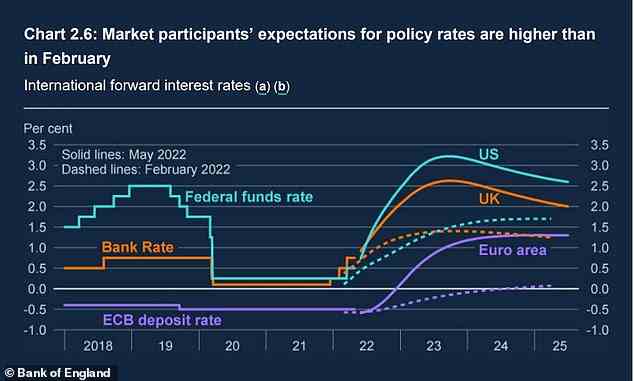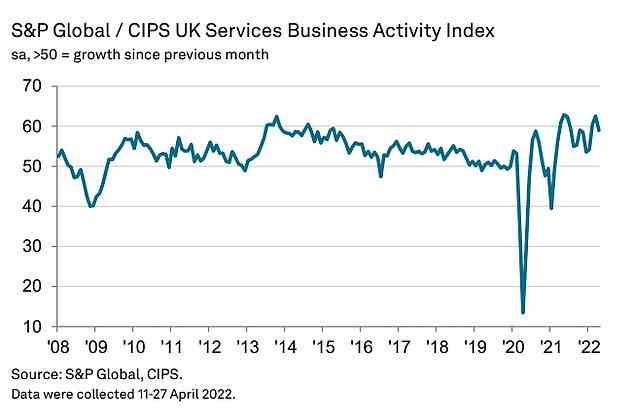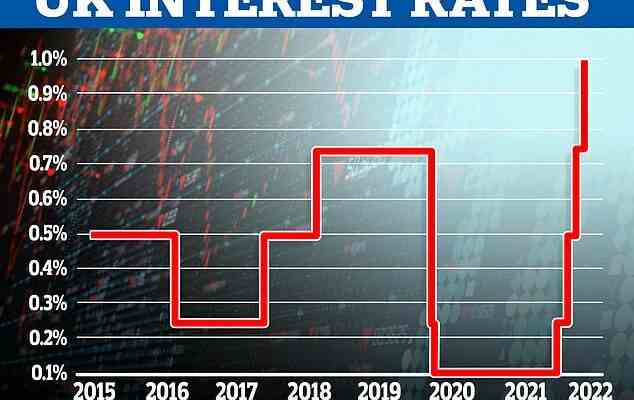The Bank of England hiked the base rate to its highest level for 13 years today, with a 0.25 per cent rise to 1 per cent.
The rate rise to battle surging inflation – now expected to average 10 per cent over autumn – should benefit savers but will hit mortgage borrowers and businesses, who face higher borrowing costs.
Led by Governor Andrew Bailey, the Monetary Policy Committee increased the key UK interest rate from 0.75 per cent to 1 per cent. Today marks the fourth meeting in a row since December that the Bank has upped interest rates.
The MPC voted by a majority of 6-3 to increase Bank Rate, as it is officially known, by 0.25 percentage points, but the members in the minority were not advocating that rates should be held and instead preferred a 0.5 percentage points rise to 1.25 per cent.
On the up: The Bank of England has upped UK interest rates to 1% today
The Bank also upped its forecast for UK inflation, which it now believes will average 10 per cent in the final three months of the year as autumn turns to winter and higher energy bills bite.
The MPC said: ‘In the May Report central projection, CPI inflation is expected to rise further over the remainder of the year, to just over 9 per cent in 2022 Q2 [second quarter] and averaging slightly over 10 per cent at its peak in 2022 Q4.
‘The majority of that further increase reflects higher household energy prices following the large rise in the Ofgem price cap in April and projected additional large increase in October.
‘The price cap mechanism means that it takes some time for increases in wholesale gas and electricity prices, and their respective futures curves, to be reflected in retail energy prices.
‘Given the operation of the price cap, consumer price inflation is likely to peak later in the United Kingdom than in many other economies, and may therefore fall back later. The expected rise in CPI inflation also reflects higher food, core goods and services prices.’

Inflation is forecast to continue its spike and now climb above 10% before falling back. This Bank of England chart shows its expectations and how energy costs are having an impact
Why is the Bank of England raising interest rates?
Consumer prices index inflation has already hit a 30-year high of 7 per cent in March – way above the 2 per cent target – and is forecast to peak in double-digits.
Central banks initially believed that the inflationary surge of the Covid recovery would be transitory, however, price rises across the economy affecting consumers and businesses have become persistent.
The Bank of England and other major central banks are now fighting to avoid high inflationary expectations becoming baked in to consumer, worker and business expectations.
The basic principle behind monetary policy is that by raising the cost of borrowing, central banks can reduce demand for it and reduce the amount of money being created by banks through loans that flows through into the economy.
Susannah Streeter, senior investment and markets analyst at Hargreaves Lansdown, said: ‘Withdrawing the pacifier of cheap money was never going to be easy, particularly with the economy at crawling place but the Bank of England has clearly judged that leaving rates low will do more harm than good even though it is set to tip the UK into a downturn.’
Today’s interest rate hike will hit around 2million borrowers with variable rate mortgages, but about three quarters of UK mortgages are protected in the near term by fixed rates.
Savers look set to, in theory, see their returns grow further, with the best savings rates already having risen substantially in recent months.
Businesses will see non-fixed rate lending and new borrowing costs rise.
> Compare the best fixed mortgage rates that you could apply for

Interest rates are expected to continue to rise this year, with base rate climbing to about 2.5 per cent in mid 2023 before falling back to 2 per cent
How high could interest rates go?
The Monetary Policy Report alongside the rate decision sets out the Bank of England’s market-implied path for the base rate.
This sees Bank Rate rising to 2.5 per cent by the middle of next year, before falling back to 2 per cent at the end of the forecast period.
Although this would see interest rates remain low by historic standards, they would be far higher than was expected until recent months.
In terms of how many times we could see rates hiked again over the coming year, Victoria Scholar, head of investment at Interactive Investor, said: ‘Financial markets and economists are divided over the number of rate hikes the central bank will carry out in the months ahead.
‘According to the overnight index swaps market ahead of the decision, traders are pricing in around six hikes including today’s move to lift the bank rate to around 2.25 per cent by December whereas more prudent economists see interest rates moving a lot more slowly, reaching 1.5 per cent by early 2023.’
Meanwhile, Vivek Paul, UK chief investment strategist at BlackRock Investment Institute, said: ‘Given the weakness of the economic outlook, we expect the Bank will ultimately choose to live with some inflation.
‘We estimate the UK’s neutral rate of interest to be lower than other key regions, such as the US, which would mean it would have less headroom for hikes than is typically assumed. As such, we see market expectations for further UK tightening as overdone, and expect UK yields will rise more slowly than U.S. equivalents.’
What is happening in the economy?
The rate hike comes as the Bank now expects economic growth to nearly grind to a halt this quarter and to contract by the end of the year.
It said gross domestic product in the first quarter was 0.9 per cent, higher than previously expected.
But growth is forecast to ‘slow sharply’ to 0.1 per cent in the current April-June quarter and to fall in the last quarter of 2022 ‘driven largely by the decline in households’ real incomes’.
The Bank’s latest projections also show the UK economy could potentially shrink next year.

GDP growth is expected to tail off and the economy could potentially shrink next year in this Bank of England forecast
Victoria Scholar, head of investment at interactive investor, says the risk the UK will fall into a recession has intensified.
‘The latest indications on the UK points to an increasingly fragile economy with consumer confidence close to the lowest level since records began almost 50 years ago, with an uninspiring 0.1 per cent GDP growth in the latest data for February and now with the IMF suggesting that UK GDP will slow to the worst among the G7 next year.
‘After last week’s data saw the US economy unexpectedly contract for the first time since mid-2020 there are growing concerns that the UK could be on track for a similar fate as the risk of a recession intensifies.’
Separate figures also released today show the rising cost of living and the war in Ukraine have slowed down the recovery of the key services sector.
The cost of living crisis is set to worsen further in October, when another increase in the energy cap is expected.
The latest S&P Global/CIPS business UK services Purchasing Managers’ Index scored 58.9 in April, down from 62.6 in March.
Services firms, which range from banks to hairdressers, account for 80 per cent of the total UK economic output, so a slowdown indicates a loss of momentum in the whole economy.

Rising costs and the war in Ukraine have slowed down the recovery of the key services sector
Businesses recorded the fastest rise in costs in almost 26 years in April, with energy, wages and fuel all going up in price. In turn, companies hiked prices they charge to customers at close to record pace.
New business growth slowed sharply and was the weakest so far this year. Meanwhile, business confidence dropped to the lowest in a year and half as firms worried about rising costs.
Andrew Harker, economics director at S&P Global, said: ‘The twin headwinds of the cost-of-living crisis and the war in Ukraine started to bite on the UK service sector during April, as evidenced by a sharp slowdown in new order growth to the lowest in the year so far.
‘Worryingly, companies seem to be expecting impacts to be prolonged, with business confidence dropping to the lowest in a year-and-a-half.
‘Indeed, cost pressures show little sign of abating, with inflation even accelerating in April to the strongest in almost 26 years of data collection.
‘The feeding through of these cost pressures to charges for customers means that the spell of rapid inflation clearly has further to run.’

In charge: Bank of England governor Andrew Bailey is under pressure amid surging inflation
Martin Beck, chief economic advisor to the EY ITEM Club, said figures suggest the UK economy is in for a sharp slowdown this quarter.
‘The forward-looking indices of April’s survey fell back at a faster rate than the headline index, suggesting growth in activity will slow further during Q2.
‘This evidence of a loss of private sector momentum reinforces the EY ITEM Club’s expectation that GDP growth will slow significantly in Q2.’
On Wednesday, the US Federal Reserve unveiled its biggest interest rate hike in over two decades as it toughens its fight against rapidly surging prices.
The Fed said it was upping its benchmark interest rate by half a percentage point, to a range of 0.75 per cent to 1 per cent after a smaller rise in March. With US inflation at a 40-year high, further hikes are expected, just as they are in the UK.
The push from the Fed marks the latest effort to contain spiking costs being felt by households around the world.
On Wednesday, India’s central bank announced an unexpected increase to its benchmark rate, while Australia’s central bank recently enacted its first interest rate hike in more than a decade.
Some links in this article may be affiliate links. If you click on them we may earn a small commission. That helps us fund This Is Money, and keep it free to use. We do not write articles to promote products. We do not allow any commercial relationship to affect our editorial independence.


